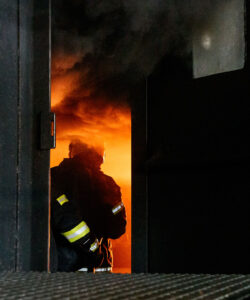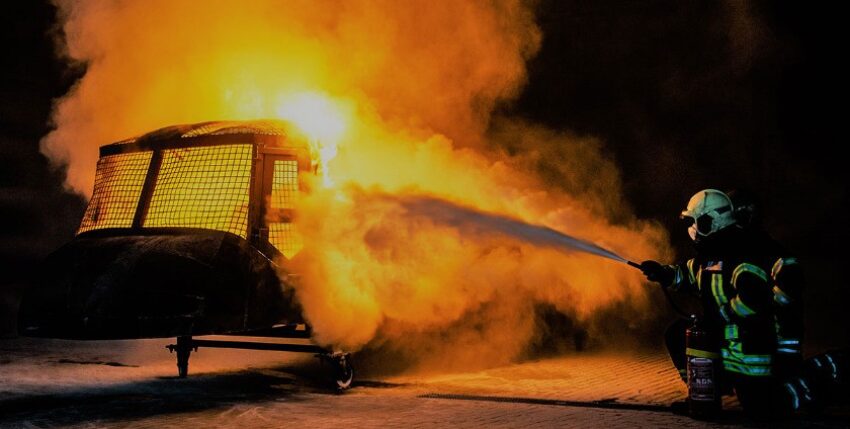Every soldier on board must be able to fight a fire. High-quality, multi-stage training is therefore essential.
The German Naval Damage Control Training Centre in Neustadt in Holstein is a training facility of the German Navy. Training is provided in operational and basic training as well as by the specialised medical service group. Operational training is responsible for training the crews of seagoing units and basic training is responsible for training divers and damage defence forces, among other things. Why does the German Navy go to such lengths and maintain its own training centre? The answer lies in the special features of seafaring on military units. Safe participation in maritime traffic is only one side of the coin. On the water, far from home and from the shore, every crew member must be able to contribute to damage defence. Firefighting plays a special role here, which is why almost every marine soldier is also a "firefighter". Training in damage defence, especially fire protection training, is therefore of particular importance to the German Navy.
Training at the Marine Damage Prevention Training Centre (EAZS M) in Neustadt has always been known for its high practical component in the subjects taught. Competence-orientated training is the consistent further development of the learning and teaching methods practised to date. Although imparting theoretical knowledge is a must, it is not the main focus. The safe application of this knowledge in practical action increases survivability in the field and is the guarantee for mission fulfilment.
In addition to numerous regulations and directives, the entire training programme is based on the shipboard damage prevention regulations and the infrastructure available at the EAZS M. In addition to the former frigate KÖLN, which has been converted into a training hulk, there is also a hot fire training facility, which realistically depicts the special features of ship firefighting. The peculiarities and special challenges of fighting a fire on board ships and boats can be found in various sources of danger such as fuel and ammunition, in the confined space, the ship's construction itself and the shipbuilding material used. Steel is the most commonly used material in shipbuilding and has excellent thermal conductivity. This can cause a fire to practically "go through walls". Smoke gases can spread very quickly inside the ship due to the chimney effect and the ventilation system and pose a very great danger, especially with the invisible components, including carbon monoxide.
Ships and boats of the German Navy are divided into ship security areas in which the damage control forces fulfil their mission. Virtually every crew member contributes to security at their level of responsibility.

is a physical
Challenge, Photo: Bw/Marcel Kröncke
Modular design
Every member of the armed forces undergoes basic training at the beginning of their service. In the German Navy, this is followed by the specially developed training module on board. This so-called "blue module" teaches what it means to serve on board seagoing units, where the focus of damage control and combat duty is to be found, and that there are specific terms and characteristic behaviours here. Many marines realise for the first time that serving on board a ship or boat is something unique and involves special challenges. An integral part of the module is training as a breathing apparatus operator. Successful participation in this training module lays the foundation for a large number of other training courses that are specifically tailored to use on board ships and boats of the German Navy. Breathing apparatus wearers are trained not only at the Bremerhaven Naval Operations School and the Parow Naval Technology School, but also at the Wilhelmshaven Naval Base and the Naval Damage Prevention Training Centre. This training, which is in line with civilian requirements, is the first step towards being able to tackle fires while protected from respiratory toxins as part of damage defence. However, this qualification alone is far from sufficient, and this is where the EAZS M plays a crucial role.
Damage defence forces on board generally never act alone. The system established in damage defence prevents ambiguities in the command structure. The firefighting team, for example, consists of at least two breathing apparatus wearers and is directed and led by a team member with the qualification of ship safety team leader. A two-week training course at the EAZS M teaches how to achieve the necessary level of qualification as a ship safety team leader. The training includes a mandatory theoretical component in the subjects of basic operational principles, leak defence, fire defence and shipboard medical services as well as many practical exercises for fighting fires and water ingress. The future ship safety team leaders learn how to deal with special conditions and how to fulfil their tasks in a targeted and confident manner.
In the hierarchical system of damage control, the ship's security team leaders receive their orders from a leader on the scene. The "On-scene ship safety leader" training course is designed for middle management levels and focuses on military leadership under combat conditions in damage control on seagoing units. Within four weeks, all training participants will apply the required knowledge from the theoretical subjects of operational basics, leak defence, fire defence and shipboard medical services in the practical part, which comprises around 60 percent of the training. This is where the performance of the training participants is assessed in the so-called leadership exercises. With a full auditorium and four exercises per training participant, a total of 80 training situations are completed. This poses a major challenge not only for the training participants, but also for the instructors. The trainers must not miss anything during the assessed leadership exercises. For this reason, up to twelve instructors are responsible for the standardised exercise sequences during the situations.
In the damage control structure, damage control forces are organised into a group. Such a ship security group is primarily active in a ship security area and consists of at least 14 people who are able to fight fires, stop water ingress and care for the injured or wounded in accordance with the specified priorities. Depending on the situation, the effective deployment of all resources must be managed and consideration must be given to the necessary relocation of personnel and equipment. This extremely challenging management task is the responsibility of the ship safety group leader. He directs and manages the leaders entrusted to him and subordinate to him at the scene of the incident, ship safety team leaders, breathing apparatus wearers and damage control forces in accordance with the ship's command. The two-week Ship Safety Team Leader training course is designed to help them fulfil this very demanding task. The prerequisite for participation is the qualification of a leader on the scene and at least six months of service as such on board ships and boats of the German Navy. The Ship Security Group Leader training is characterised by even more intensive practical training and is the highest qualification in damage control for the middle management level.
The most comprehensive training in the area of damage defence is the six-week "Damage Defence Officer" training course. Every officer on board has completed this modular training programme, which is tailored to the requirements of a naval officer's training course. Starting with the complete training as a breathing apparatus operator, the theoretical and practical parts of the training are taught for the qualification levels of ship safety team leader, leader at the scene and ship safety group leader. As future officers with overall responsibility for damage defence and firefighting or as representatives of the commander as part of their watch duties, the aim is to teach the officers the basics of safe leadership in complex damage situations under difficult conditions. This training concludes with the "Fire in a ship" exercise in the harbour. In this complex scenario, known as a harbour firefighting role, it is important to maintain an overview of personnel and equipment in cooperation with a fire brigade and not to lose control in the face of all surrounding influences.

Realisation of the training content
Firefighting training is divided into several practical sections. Once a year, the breathing apparatus wearers have to complete a defined course in a breathing apparatus training facility in full protective equipment and prove that they are physically able to cope with the strain. The protection and safety of the training participants always has top priority. This is why everyone who practises firefighting under heavy breathing protection at the EAZS M must pass this endurance exercise again at the beginning of the training. However, before training participants are required to extinguish fires on board, there is practice in the fire training hall. In the section that can be used without heavy breathing protection, training is given on small extinguishers such as hand-held powder extinguishers and fire extinguishers for water and foam. Every training participant can experience the feeling of successful firefighting, because success in this training facility depends on their own competent actions. The instructors ensure safety and intervene if necessary. The Ex-KÖLN training hulk not only has the visual appearance of a ship, but also conveys as soon as you step on board that the conditions on board are different to those on land. The Ex-KÖLN has a total of three ship safety areas with three so-called large fire zones, six small fire zones and various practice areas for leak fighting. The large fires are located in the former propulsion and electrical engineering rooms. They pose an enormous challenge for the training participants even on the way to the fire site due to the limited visibility, the restricted manoeuvrability caused by wearing protective equipment and carrying fire extinguishing equipment and the special access routes through the companionways. Success in firefighting comes when the fire is actually extinguished, because that is the big challenge: there is no emergency stop button! Here too, the instructors ensure the necessary safety and intervene to provide support if necessary. By activating fires on the smaller fire scenes, the training participants' ability to react and act safely with portable fire extinguishers can be practised. The fire hall also has a very special hot fire training system for firefighting under heavy breathing protection. Here, the variable height of the flue gas layer makes it possible to convey poor visibility and heat in a tangible way. In this three-room steel construction, which resembles a section of a ship, the level of difficulty can be individually customised and adjusted to the training participants. The highest demands are placed on training participants and instructors in this hot fire training facility. Extremely hot smoke gases can make firefighting extremely difficult. This system provides impressive training in how to "read" the fire correctly without ignoring the smoke gases.

A look into the future
It is not only the constant further development of learning and teaching methods with all their content that guarantees state-of-the-art training, the necessary infrastructure must not be lost sight of either. The administrative steps required to replace the Ex-KÖLN training hulk have been completed and are being processed by the Bundeswehr Planning Office. In addition to the infrastructure itself, it is also important to recruit personnel and retain them for as long as possible. A great deal of time must be invested in the training of instructors in order to provide high-quality training, and a large number of approvals and authorisations are required to ensure this. Continuous further development also includes equipment for damage defence. Future plans for firefighting and damage defence capabilities allow us to look to the future with confidence. Until then, the challenge remains to get the best out of the available resources.
Frigate Captain Andreas Steinfeld works in basic training at the Naval Damage Prevention Training Centre as Head of the Operational Basics Department.
Andreas Steinfeld










